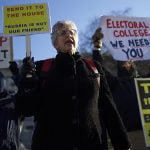
High up in the mountains of the Navajo Nation in New Mexico, Delphine Gatewood teaches special education at the Crystal Boarding School. She’s dreading this winter, like she dreads every winter, because temperatures can slip into the negative digits which the school building just can’t handle.
“You have a boiler system that regulates heat at one certain temperature so you can’t turn it down,” she says. “It gets so hot in the classroom and you have to open the windows in the dead of winter.”
The Crystal Boarding School isn’t part of any local school district in New Mexico. It’s overseen at the federal level by the U.S. Bureau of Indian Education. As are nearly 200 other Native American schools nationwide.
In 2015, Arne Duncan, the secretary of education at the time, called the bureau “the epitome of broken.” The federal school system has been around for more than 150 years, marred by a past of forcefully assimilating students, rock-bottom academic performance and a crumbling infrastructure.
That’s why the Obama administration has been pouring resources into leading an effort with the bureau to change the way it serves the 50,000 students attending its schools nationwide.
The bureau has said it hopes to shift into a role that provides more support, rather than issue directives. In other words, shift away from being a direct overseer of schools and give local control to tribal communities.
Infrastructure
Officials at the Bureau of Indian Education estimate that roughly one-third of their school buildings are in poor condition. To fix them, they say it’ll take more than $1.3 billion. That’s why a big part of the reform effort is to build new schools and repair old ones.
Delphine Gatewood is a both a teacher at Crystal and the grandmother of a kindergartner, first- and fifth-grader here. She says it’s hard for her grandchildren to learn at such a run-down, neglected campus. Crystal is one of 10 bureau schools in line to get a brand new facility.
A new school should also free up time for the principal and other administrative staff to focus on student education, and less time trying to repair this 85-year-old facility.
Academics
“We needed to change the way we were doing business,” says Tony Dearman, the new director of the Bureau of Indian Education.
Consider this: Right now fourth graders are scoring 22 points lower in reading and 14 points lower in math than Native American students in public schools.
“The system that we used to have at [the bureau was] one size fits all,” he says, “and one size fits all in the tribal nations, that’s not realistic. That doesn’t work.”
Dearman says they’ve got to do better — because when kids go through school without learning what they need to, it limits economic opportunity throughout their lives.
He says the bureau is encouraging more tribes to take control of their schools because he acknowledges local officials know more about the needs and cultural traditions of students than bureaucrats in Washington, D.C.
Cultural education
The Crystal Boarding School offers something state-run public schools on the reservation don’t: immersive Navajo cultural education. Students learn the Navajo language and traditional songs and dances on a daily basis.
It wasn’t always this way, though, points out Donald Fixico. He’s a historian at Arizona State University. He says bureau boarding schools, like Crystal, were once a place where Native American children were sent to assimilate.
“It was really — save the Indian child but forego all the tribal culture and old ways and languages by the kids,” he says.
That was the 19th and early 20th centuries. Back in the 1970s tribes were given more control over cultural education, and new changes take it even further.
Today Fixico says the bureau is a very different place, “because native people are in control of the schools. They’re in control of the curriculum, how it develops, what needs to be taught, supplying the instructors. It’s a whole different ballgame altogether.”
Still, many tribal members across the country say they’re skeptical the reform efforts, and all of the resources put into them, will make any real difference in student performance. And, the transition hasn’t been without controversy.
One of those skeptics is Delphine Gatewood. She says she’s hoping for the best, if only for the future of her grandchildren.
[SOURCE:-NPR]


